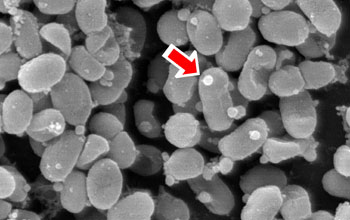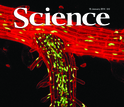News Release 14-005
Researchers report on new dimension of marine cyanobacteria
Marine scientists at NSF's Center for Microbial Oceanography discover extracellular vesicles produced by ocean microbes

Scanning electron micrograph of the marine cyanobacterium, with visible vesicles.
January 9, 2014
This material is available primarily for archival purposes. Telephone numbers or other contact information may be out of date; please see current contact information at media contacts.
Marine cyanobacteria are the tiny ocean plants that form the base of the ocean's food chain. Other organisms feed on them and are nourished by the oxygen they provide.
Marine scientists working at NSF's Center for Microbial Oceanography: Research and Education in Hawai‘i, known as C-MORE, have discovered another important dimension of the outsized role played by these tiny cells: The cyanobacteria continually produce and release vesicles, spherical packages containing carbon and other nutrients that can serve as food parcels for marine organisms. The vesicles also contain DNA, likely providing a means of gene transfer within and among communities of similar bacteria, and they may even act as decoys for deflecting viruses.
Although extracellular vesicles were discovered in the 1960s and have been studied in human-related bacteria, this team discovered evidence of their existence for the first time in the ocean, providing greater context for understanding these structures and their importance in the exchange of genetic material in marine organisms.
"This world-class team integrates molecular ecology, genomics and ecological modeling with remote sensing technology to enhance our knowledge about the marine microbial community and its relationship to origins of life on earth," said Dragana Brzakovic, NSF program director in the Office of International and Integrative Activities.
The journal Science published the findings today in a paper titled, Bacterial Vesicles in Marine Ecosystems. Massachusetts Institute of Technology (MIT) postdoc Steven Biller, Professor Sallie (Penny) Chisholm of the MIT Department of Civil and Environmental Engineering and several co-authors reported on their discovery of large numbers of extracellular vesicles associated with the two most abundant types of cyanobacteria, Prochlorococcus and Synechococcus.
The researchers found vesicles (each about 100 nanometers in diameter) suspended in cultures of the cyanobacteria as well as in seawater samples taken from both the nutrient-rich coastal waters of New England and the nutrient-sparse waters of the Sargasso Sea, located in the middle of the North Atlantic Ocean.
"The finding that vesicles are so abundant in the oceans really expands the context in which we need to understand these structures," says Biller, first author on the Science paper. "Vesicles are a previously unrecognized and unexplored component of the dissolved organic carbon in marine ecosystems, and they could prove to be an important vehicle for genetic and biogeochemical exchange in the oceans."
Biller's analysis of the genetic material in the vesicles recovered directly from the environmental samples of sea water revealed sequences from a diverse array of bacteria, suggesting that vesicle production is common to many marine microbes. The researchers estimate the global production of vesicles by Prochlorococcus alone at billions of billions per day--representing a notable addition of carbon to the scarce nutrient pool of the open seas.
Lab experiments showed that the vesicles are stable, lasting two weeks or more, and that the organic carbon they contain provides enough nutrients to support the growth of nonphotosynthetic bacteria.
Given the dearth of nutrients in the open ocean, the daily release by an organism of a packet one-sixth the size of its own body is puzzling, Chisholm says. Prochlorococcus has lost the ability to neutralize certain chemicals and depends on nonphotosynthetic bacteria to break down chemicals that would otherwise act as toxins. It's possible the vesicle "snack packets" help make this relationship mutually beneficial.
"Prochlorococcus is the smallest genome that can make organic carbon from sunlight and carbon dioxide and it's packaging this carbon and releasing it into the seawater around it," says Chisholm, the Lee and Geraldine Martin Professor of Environmental Studies in MIT's Department of Civil and Environmental Engineering and Department of Biology, who is lead investigator of the study. "There must be an evolutionary advantage to doing this. Our challenge is to figure out what it is."
Because the vesicles also contain DNA and RNA, the researchers surmise they could play a role in horizontal gene transfer, a means for developing genetic diversity and sharing ecologically useful genes among the Prochlorococcus metapopulation.
Researchers discovered that the most unusual potential role of the vesicles is as a decoy for predators: electron microscopy shows phages (viruses that attack bacteria) attached to vesicles.
To read more about this discovery, visit Ahoy! First ocean vesicles spotted; Scientists discover extracellular vesicles produced by ocean microbes.
The Center for Microbial Oceanography: Research and Education (C-MORE) is one of 17 National Science Foundation Science and Technology Centers (NSF-STC) across the nation, and the only one in Hawai‘i. The NSF-STC program exists to create partnerships to study large, complex problems of great scientific and societal relevance. C-MORE's focus is on the key role that marine microorganisms play in sustaining a habitable planet from solar energy capture to food production to the sequestration of carbon dioxide.
Over the past 3.5 to 4 billion years, microorganisms have shaped and defined Earth's biosphere and created conditions that allowed the evolution of macroorganisms and complex biological communities including human societies. Microorganisms are the foundation of life and are key to Earth's habitability and sustainability. Now there is a unique opportunity to achieve a comprehensive understanding of life in the sea and its susceptibility to environmental variability and human-induced climate change.
To accomplish its mission, the Center brings together individuals from across various institutions who might otherwise have little opportunity to interact. Based at the University of Hawai‘i at Mânoa, the interdisciplinary team includes scientists, engineers and educators from MIT, the Monterey Bay Aquarium Research Institute, Oregon State University, the University of California, Santa Cruz and Woods Hole Oceanographic Institution.
C-MORE, first funded for five years in 2006, with renewed funding awarded in 2011, is part of NSF's Science and Technology Center program, which supports integrative partnerships that require large-scale, long-term investments to pursue world class research and education. STCs study a wide range of complex scientific topics such as atmospheric modeling, energy-efficient electronics, water purification techniques, evolution and cybersecurity.
-NSF-
-
The researchers' findings are described in the Jan. 10, 2014, issue of Science.
Credit and Larger Version
Media Contacts
Lisa-Joy Zgorski, NSF, (703) 292-8311, email: lisajoy@nsf.gov
Denise Brehm, MIT, (617) 253-8069, email: brehm@mit.edu
Program Contacts
Dragana Brzakovic, NSF, (703) 292-8040, email: dbrzakov@nsf.gov
Matthew D. Kane, NSF, (703) 292-7186, email: mkane@nsf.gov
Related Websites
NSF's Science and Technology Centers: http://www.nsf.gov/od/iia/programs/stc/
MIT's Department of Civil & Environmental Engineering: https://cee.mit.edu/aboutcee
Center for Microbial Oceanography: Research and Education (C-MORE): http://cmore.soest.hawaii.edu/cruises/big_rapa/cmore.htm
The U.S. National Science Foundation propels the nation forward by advancing fundamental research in all fields of science and engineering. NSF supports research and people by providing facilities, instruments and funding to support their ingenuity and sustain the U.S. as a global leader in research and innovation. With a fiscal year 2023 budget of $9.5 billion, NSF funds reach all 50 states through grants to nearly 2,000 colleges, universities and institutions. Each year, NSF receives more than 40,000 competitive proposals and makes about 11,000 new awards. Those awards include support for cooperative research with industry, Arctic and Antarctic research and operations, and U.S. participation in international scientific efforts.
Connect with us online
NSF website: nsf.gov
NSF News: nsf.gov/news
For News Media: nsf.gov/news/newsroom
Statistics: nsf.gov/statistics/
Awards database: nsf.gov/awardsearch/
Follow us on social
Twitter: twitter.com/NSF
Facebook: facebook.com/US.NSF
Instagram: instagram.com/nsfgov

